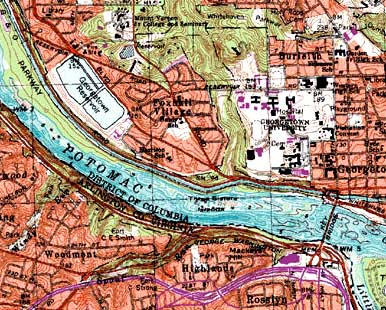USGS GeoData Digital Raster Graphics
Fact Sheet 088-01 (September 2001)
|| Specifications ||
Replacement & New Version of DRGs ||
Projections & Datums ||
|| Positional &
Attribute Accuracy ||
Uses of a DRG
|| Distribution Media ||
|| Obtaining DRGs
|| Information ||
 |
|
A part of the Washington West, D.C.
digital raster graphic. |
A digital raster graphic (DRG) is a scanned image of a U.S.
Geological Survey (USGS) topographic map. The scanned image
includes all map collar information. The image inside the map
neatline is georeferenced to the surface of the Earth.
Between 1995 and 1998, the USGS produced DRGs of the
1:20,000- (Puerto Rico) 1:24,000-,1:25,000-, 1:30,000-
(Caribbean Islands), 1:63,360- (Alaska), 1:100,000-, and
1:250,000-scale topographic map series.
Specifications
Most USGS 7.5-minute DRGs produced between 1995 and 1998 have
the following specifications:
- The source material for a DRG is a USGS topographic
paper map.
- USGS DRGs are in TIFF 6.0 format, with GeoTIFF 0.2 or
1.0 extensions to define georeferencing.
- The map is scanned at a minimum resolution of 250 dots
per inch (dpi). If scanned at a finer resolution, the image
is resampled to 250 dpi.
- The digital image is georeferenced to the true ground
coordinates of the 2.5-minute grid ticks and projected to
the Universal Transverse Mercator (UTM) for projection
consistency with USGS digital orthophoto quadrangles (DOQ)
and digital line graphs (DLG).
- Color values are standard between DRG quadrangles. The
USGS uses up to 13 colors on each DRG. The image is an 8-bit
palette-color image in a compressed TIFF file.
- The digital image is accompanied by a metadata file that
complies with the Federal Geographic Data committee's
"Content Standards for Digital Geospatial Metadata" (June 8,
1994).
|| Top || Main table
of contents ||
Replacement and New Version
Digital Raster Graphics
Although the original data program was completed in 1998, the
USGS has continued to make new DRGs for two reasons:
- To replace data found to contain errors.
- To make new DRGs of revised maps.
About 1,000 replacement and new version DRGs per year have
been produced since the completion of the original data program.
In addition, many DRGs have been made of maps other than
standard topographic quadrangles, such as National Park Maps,
maps of Antarctica, and geologic and hydrologic maps.
In some cases, new DRGs are derived directly from digital
data rather than from scans of the paper map.
Changes to the technical specifications for DRGs to
accommodate different maps and data sources are under
consideration.
|| Top || Main table
of contents ||
To be consistent with other USGS digital data, the image is
cast on the UTM projection. The digital image will, therefore,
usually not be consistent with the credit note on the image
collar. Only the area inside the map standard cell boundary is
georeferenced. Minor distortion of the text may occur in the map
collar. Overedge areas and inset maps are not georeferenced.
In most cases, the datum of the source map is preserved in
the DRG. That is, if a map is published on the 1927 North
American Datum, the DRG is also on this datum.
|| Top || Main table
of contents ||
The horizontal positional accuracy of a DRG is approximately
the same as the accuracy of the published source map. The DRG
georeferencing process removes errors caused by material
stretching and shrinking, but human pointing mistakes may
introduce other small errors. In most cases, errors in the DRG
are small compared with sources of error in the original map
graphic.
A USGS DRG has a standard color palette of 13 colors,
intended to model the line-drawing nature of the source graphic.
The colors are indexed according to the TIFF standard, with the
additional requirement that the TIFF color look-up table be
exactly the same for every DRG. The colors are always indexed in
the same order, with the same red-green-blue values. Variations
in paper map colors caused by different brands of ink, different
printing presses, the age of the map, and other factors lead to
misclassification of pixel colors in the DRG. Most DRGs made by
scanning paper maps contain significant amounts of color noise,
especially in areas filled by lithographic screen tints.
|| Top || Main table
of contents ||
DRGs are useful as backdrops onto which other digital data
can be overlaid. At the USGS, DRGs are used for collecting and
validating DLGs. The DRG can help assess the completeness of
digital data from other mapping agencies. It can also be used to
produce "hybrid" products. These include combined DRGs and DOQs
for revising and collecting digital data and combined DRGs and
digital elevation models for creating shaded-relief maps.
|| Top || Main table
of contents ||
The USGS distributes DRGs on a variety of media, including
CD-R, DVD, and FTP as uncompressed files.
|| Top || Main table
of contents ||
For information on these and other products and services,
contact one of customer service representatives at
800-248-6277 or
Sales@GeoMart.com
|| Top || Main table
of contents ||
|
